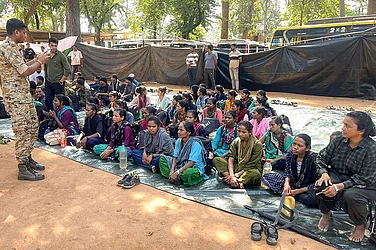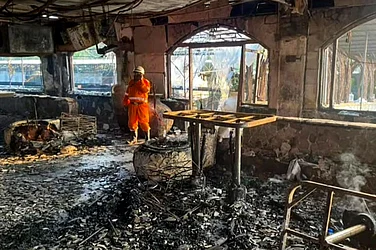Ahead of the 78th Independence Day, the National Aerospace Laboratories (NAL) unveiled that it is developing potent indigenous Kamikaze Drones -- also known as loitering munitions. These "do-an-die" unmanned aerial vehicles (UAVs) are designed to fly up to 1,000 kilometers with home-built engines.
Often referred to as do-and-die machines, Kamikaze drones have gained significance in recent times, including the Russia-Ukraine war and the Israel-Hamas war.
These drones loiter in a target area for an extended period, carrying explosives, and then crash into the target when commanded by a remote operator, sitting in a different location. They can be used strategically to overpower enemy defenses and attack high-value targets.
Measuring 2.8 meters in length and 3.5 meters in wingspan, the Indian Kamikaze drone will carry a 25 kg explosive payload and weigh around 120 kg. The endurance of the drone of around nine hours enables it to loiter for an extended time and identify the target before initiating the suicide mission, as per defence.in.
Director of the National Aerospace Laboratories, Dr Abhay Pashilkar, who is also leading the research, said, "India is developing these fully indigenous kamikaze drones, they are game-changing 21st century new age war machine."
With CSIR-NAL as the nodal laboratory and other CSIR engineering laboratories participating, the Council of Scientific and Industrial Research (CSIR) granted an in-principle approval for a project on Loitering Munitions.
A 30-horsepower Wankel Engine developed by NAL will power the Indian Kamikaze drone. The do-and-die machine will be capable of operating in environments with no GPS access, utilising the Indian NAViC navigation system for guidance and target identification.
Pressing on the potential of these drones, Pashilkar said, "such drones deployed by other nations have shown great potential in the modern ongoing wars elsewhere".
India Fast Tracks US 'Hunter-Killer' Drones Deal
Eyeing China and Pakistan as they boost their armed drones fleet, India is fast-tracking negotiations for acquiring 31 weaponised MQ-9B 'hunter-killer' drones from the United States.
The discussions for this inter-governmental deal are in an "advanced stage now", with 15 of 31 drones earmarked for Navy and 8 each for Army and IAF, Times of India reported citing defence ministry sources.
The deal comes at a time when Pakistan has sought 16 more armed CH-4 drones from China, the report added. The supply has also stepped up the supply of its armed Cai Hong-4 and Wing Loong-II drones to Pakistan.
The MQ-9B Reaper or Predator drones are designed to fly for around 40 hours at over 40,000 feet for surveillance, armed with air-to-ground missiles and smart bombs for precision strikes. These are considered to be superior over the Chinese armed drones.
The US has put a price of $3.9 billion for the 31 weaponised MQ-9B drones and its associated equipment -- 170 Hellfire missiles, 310 GBU-39B precision-guided glide bombs, navigation systems, sensor suits and mobile ground control systems. However, the Indian government's negotiation team is working to bring down the costs.


























